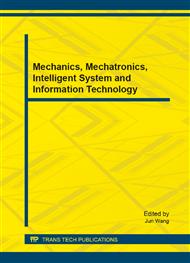[1]
Li, Yang, and Li Guo. An active learning based TCM-KNN algorithm for supervised network intrusion detection. Computers & security 26. 7 (2007): 459-467.
DOI: 10.1016/j.cose.2007.10.002
Google Scholar
[2]
Mukherjee B, Heberlein L T, Levitt K N. Network intrusion detection. Network, IEEE, (1994).
Google Scholar
[3]
Mukkamala S, Janoski G, Sung A. Intrusion detection using neural networks and support vector machines. Neural Networks, 2002. IJCNN'02. Proceedings of the 2002 International Joint Conference on. IEEE, 2002, 2: 1702-1707.
DOI: 10.1109/ijcnn.2002.1007774
Google Scholar
[4]
Botha M, von Solms R. Utilising fuzzy logic and trend analysis for effective intrusion detection. Computers & Security, 2003, 22(5): 423-434.
DOI: 10.1016/s0167-4048(03)00511-x
Google Scholar
[5]
Debar H, Becker M, Siboni D. A neural network component for an intrusion detection system. Research in Security and Privacy, 1992. Proceedings, 1992 IEEE Computer Society Symposium on. IEEE, 1992: 240-250.
DOI: 10.1109/risp.1992.213257
Google Scholar
[6]
Liao Y, Vemuri V R. Use of K-nearest neighbor classifier for intrusion detection. Computers & Security, 2002, 21(5): 439-448.
DOI: 10.1016/s0167-4048(02)00514-x
Google Scholar
[7]
Jamdagni A, Tan Z, He X, et al. RePIDS: A multi tier Real-time Payload-based Intrusion Detection System. Computer Networks, 2013, 57(3): 811-824.
DOI: 10.1016/j.comnet.2012.10.002
Google Scholar
[8]
Chen W H, Hsu S H, Shen H P. Application of SVM and ANN for intrusion detection. Computers & Operations Research, 2005, 32(10): 2617-2634.
DOI: 10.1016/j.cor.2004.03.019
Google Scholar
[9]
Rao X, Dong C X, Yang S Q. An intrusion detection system based on support vector machine. Journal of Software, 2003, 4(14).
Google Scholar
[10]
Li Y, Guo L. An active learning based TCM-KNN algorithm for supervised network intrusion detection. Computers & security, 2007, 26(7): 459-467.
DOI: 10.1016/j.cose.2007.10.002
Google Scholar
[11]
Li Y, Xia J, Zhang S, et al. An efficient intrusion detection system based on support vector machines and gradually feature removal method. Expert Systems with Applications, 2012, 39(1): 424-430.
DOI: 10.1016/j.eswa.2011.07.032
Google Scholar
[12]
Parkinson J, Blaxter M. SimiTri—visualizing similarity relationships for groups of sequences. Bioinformatics, 2003, 19(3): 390-395.
DOI: 10.1093/bioinformatics/btf870
Google Scholar
[13]
Tsai, Chih-Fong, and Chia-Ying Lin. A triangle area based nearest neighbors approach to intrusion detection., Pattern Recognition, 2010, 43. 1: 222-229.
DOI: 10.1016/j.patcog.2009.05.017
Google Scholar
[14]
Luo B, Xia J. A novel intrusion detection system based on feature generation with visualization strategy. Expert Systems with Applications, 2014. (In press).
DOI: 10.1016/j.eswa.2013.12.048
Google Scholar


